Mark Sisson's Blog, page 322
October 15, 2013
Top 10 Paleo Party Rules
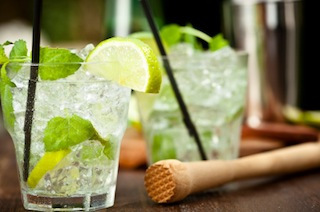 It’s Friday! You worked all week, made healthy meals, hit the gym, ran errands, did laundry, walked the dog, and cleaned the house. Now, you think, it’s time for a reward – Happy Hour. So, do you ditch the diet and savor a sweet syrupy mudslide while popping pieces of fried calamari and gossiping with friends? Or do you go home and slump into your couch with a bowl of salad? Fortunately, staying healthy and leading an active social life doesn’t have to be so black and white. Enter Kelly Milton. Kelly is an expert when it comes to paleo entertaining and navigating the social scene. She blogs at paleogirlskitchen.com and is the author of Paleo Happy Hour. In this guest post, she outlines ten party rules that will help you stay paleo in a social setting without feeling excluded or falling off the paleo wagon.
It’s Friday! You worked all week, made healthy meals, hit the gym, ran errands, did laundry, walked the dog, and cleaned the house. Now, you think, it’s time for a reward – Happy Hour. So, do you ditch the diet and savor a sweet syrupy mudslide while popping pieces of fried calamari and gossiping with friends? Or do you go home and slump into your couch with a bowl of salad? Fortunately, staying healthy and leading an active social life doesn’t have to be so black and white. Enter Kelly Milton. Kelly is an expert when it comes to paleo entertaining and navigating the social scene. She blogs at paleogirlskitchen.com and is the author of Paleo Happy Hour. In this guest post, she outlines ten party rules that will help you stay paleo in a social setting without feeling excluded or falling off the paleo wagon.
The 10 Paleo Party Rules!
One of the biggest challenges as a paleo follower can be the desire for an active social life. You still want to meet up with friends for dinner, attend parties and throw them; all while feeling included and true to your diet. Drinking alcohol is not paleo, it’s true, but it is a part of many people’s lives. The paleo community hasn’t spent much time laying out your options for alcohol and mixers. Also, even if you feel confident in what to drink, the social scene can still pose many other challenges. For some quick tips to keep in mind when attending social functions, I have created The 10 Paleo Party Rules.
1. Food First
Think about food before anything else. If you will be going out drinking, eat a high protein low carbohydrate meal beforehand. You will get plenty of carbohydrates in your cocktails, so stick to protein and non-starchy vegetables for your pre-party meal while making sure to get in some healthy fats. A full stomach helps slow down the absorption of alcohol. WARNING: Do not skip dinner because you are planning on “drinking” your dinner. Alcoholic beverages can cause blood sugar spikes. By skipping a meal you will only make blood sugar spikes worse, causing an increase in the absorption of alcohol.
Eating after you have been drinking is another issue. You may find yourself hungry without any paleo options. So, pack a snack in your purse, pocket, or car (like trail mix or jerky) so you won’t be tempted to eat pizza at 2 a.m. If you’re going to a dinner or house party, bring a healthy food option to share so you aren’t stranded with nothing to eat.
2. Be Prepared
Set goals for the night before you go out. According to the National Institute on Alcohol Abuse and Alcoholism, men should have no more than four drinks on a single day and fourteen per week; women no more than three drinks per day and seven per week. Keep in mind serving sizes on typical drinks when counting. Decide how many alcoholic beverages you plan to drink that night before you go. Also, the act of planning a cut-off point can help you to remember to count your drinks throughout the night and stay at a low and healthy number. Rehearse turning down unhealthy options like sugary mixed shots or chips and spinach dip. This will make it easier when the foreseeable challenges arise.
3. Practice the Every-Other Rule
This rule is to alternate water between each alcoholic drink. When you are at a party it is comfortable to have a drink in hand, but no one said that it had to be alcoholic. Try having water between alcoholic drinks. This will help keep you hydrated and reduce the number of alcoholic drinks you consume. There is a misconception that having water will sober you up. However, the hydration you will get from the water can help save you from a hangover and slow your overall consumption of alcohol.
4. Be a Giver
Share your new favorite paleo drink or food recipe. Don’t hold out on your friends! Bring healthy food and drink options to any party. Nothing is worse than feeling left out because there are no paleo options at a party, so be proactive in bringing your own food and drinks with you. Here are 50 paleo appetizers and some paleo drinks that you can bring to any party. Also, check out this infographic for more paleo drink ideas (click to enlarge):
5. Use Your Carbs
Ditch your drink, and get on the dance floor. Move while you are out partying. Dancing, walking between bars and restaurants, or standing (away from the buffet table) will help use up those extra carbs. Plus, getting on the dance floor allows you to leave your drink behind and free up your arms for dancing!
6. Don’t Preach; Do.
Oftentimes people say there are things you just don’t talk about with friends or at parties like politics and religion. I challenge you to add paleo to the list. Many paleo followers are very passionate about the health advantages that the diet brings, and on the flip side, can be very critical of the standard American diet. It is good to feel strong about your beliefs, but it is important to be a role model rather than a preacher. Be the person at the party with the most energy, a great figure and who demonstrates healthy food choices: be the example! Giving a five-minute lecture on why gluten is death will most likely not inspire your fellow partygoers, but will probably offend, alienate or enrage other guests. If someone asks you about it, give a short, heart-felt answer and then move on.
7. Fake It Till You Make It
I’m typically not one to promote deception, lying, or faking anything. When it comes to alcohol, however, I think this can be a valid choice. No matter your age, there is still a lot of peer pressure to drink. Sometimes I think you can even pressure yourself to drink. To avoid friends questioning your sobriety, or chanting for you to grab a glass of wine, it may be easier to just fake it. I was recently at a brew fest where everyone’s beer steins were filled to the rim with glutinous beer. I quickly found the other refreshments and filled mine with iced tea and a splash of lemonade. It pretty much looked exactly the same. If you don’t feel like justifying your choice not to drink, and want the comfort of having something in hand to sip, this may be your best option. At bars, just order a club soda with fresh lime which easily passes as a vodka soda. Your wallet and your waste line will thank you later.
8. Move On
Whether you had two drinks or five and also devoured a late-night pizza, wake-up the next day and get back on track. You will have extra carbs to burn, so plan to exercise. Even if it’s just a long walk, moving your body is a good choice. Don’t fuel your hangover with greasy food. Pick up your paleo diet right where you left off.
9. Create Community
Surround yourself with friends who share or support your health values. I great place to meet like-minded people is at the gym or health food store. Plan social activities together that don’t revolve around food or drinks. Participate in the paleo online community for even more support.
10. Don’t Stress
YOLO (you only live once)! You need to enjoy life and the paleo lifestyle. Beating yourself up and feeling bad every time you slip isn’t any way to live. Paleo isn’t a test. If you get upset about every little “cheat,” you are more likely to quit altogether. If you are eating real food and living the paleo lifestyle you are way ahead of the curve. So, don’t stress, and celebrate every small victory!
For more information on how to integrate paleo into your social life get a copy of Paleo Happy Hour. Also, here are some more resources on alcohol and its role in your Primal/paleo diet:
Choose Your Booze: A Guide to Healthy Drinking – Mark’s Daily Apple
Alcohol: The Good and the Bad – Mark’s Daily Apple
Hangover Hacks You Can Hang Your Hat On – Mark’s Daily Apple
Drinking while on the paleo diet – Robb Wolf
Paleo Drinking Cheat Sheet – Paleo Girl’s Kitchen
Paleo Plus Alcohol: Now We’re Talkin’ – The Hunter and the Farmer
Let us know what you think, and share your party tips in the comment board!
Limited Time Offer: Get a FREE Copy of Primal Blueprint Healthy Sauces, Dressings & Toppings ($29.95 Value) When You Order Primal Fuel Chocolate Coconut or Vanilla Coconut Creme on Autoship>>

October 14, 2013
Dear Mark: Bodyweight or Barbells, Restaurant Traps, Primal Egg Coffee Stability, and Post-Exercise Insomnia
 Today’s Dear Mark is a four-parter with some fantastic questions (and passable answers, I hope!). First up, I answer a reader question from the comment section of last week’s Barbell Dogma post. Second, I discuss the number one nutritional trap of restaurant foods, and it has nothing to do with grains, sugar, or carbohydrates. After that, I field a question about the stability of the yolks in Primal Egg Coffee allowed to sit in a thermos for several hours. And finally, I present a few strategies for combating the insomnia resulting from a post-exercise late night cortisol rush.
Today’s Dear Mark is a four-parter with some fantastic questions (and passable answers, I hope!). First up, I answer a reader question from the comment section of last week’s Barbell Dogma post. Second, I discuss the number one nutritional trap of restaurant foods, and it has nothing to do with grains, sugar, or carbohydrates. After that, I field a question about the stability of the yolks in Primal Egg Coffee allowed to sit in a thermos for several hours. And finally, I present a few strategies for combating the insomnia resulting from a post-exercise late night cortisol rush.
Let’s go:
I’m a bit discouraged by this article. Mark’s PBF seems to say bodyweight is a great way to be strong, fit, and lean. But he clearly says in this article that barbell is the superior way to go – only he’d basically be more tactful in communicating that to people depending on where they are on the journey. I’m confused, is he basically saying if you can get access to barbells, you’re better off in the long run?
Sorry for the confusion, guys. Allow me to clarify my position.
If you’re interested in getting as strong and powerful as possible, you will want to incorporate barbells. If you’re a football player, powerlifter, weightlifter, or strongman competitor, you’re going to use barbells in your training. If you’re training to be an “elite athlete,” you’ll want to lift some iron bars with weight plates at either end.
That’s not everyone, though. Or even most people. If you just want to be fitter, stronger, faster, and healthier than your old self and the people around you while maintaining your mobility well into old age, bodyweight training is perfect. That’s exactly why I suggested it, and why I use it as the foundation for my own training: it’s effective, protective, adaptable, and totally mobile. Everyone regardless of age or health can benefit from it without consulting a professional or buying equipment. It can get you strong and fit “enough” (to play, to maintain mobility, to look good naked, etc).
Revisit Primal Blueprint Fitness if you haven’t in awhile. You’ll find that bodyweight training is recommended as the most inclusive form of strength training, but it’s not touted as the pinnacle. I even suggest that further progression with all the movements will require added weight, whether that’s a weight vest, a sandbag, or a barbell.
Everyone can benefit from barbell work, provided they can use them safely and their primary goal is more strength. Everyone can benefit from bodyweight training. That was the point of last week’s post – it (mostly) all works! There is no one answer. The answer depends entirely on your context: your goals, your mobility, your injury status, and a host of other factors.
We try to eat the right things at restaurants. What, in your experience or analysis, are some of the worst seemingly primal restaurant meal “traps”?
I’ve read as many of your blogs near this subject as I can, nothing seems to squarely address it.
How to Eat Healthy Dining Out seems closest but doesn’t quite talk about the dangers, or the seemingly-primal-but-aren’t traps.
Wayne
The biggest, sneakiest offender is the seed oil most restaurant food swims in. The stuff is incredibly cheap and pervasive. Taste-wise, it’s pretty inoffensive unless your senses are honed to pick up on it. I can usually tell if something has been cooked in it. Fast food restaurants (even just driving past them) smell like burnt oil to me.
Grains are easy to avoid. Sugar, easy. But vegetable oil? Very hard.
You could get the Mongolian beef sans rice, think you’re made off like a bandit, only to end up consuming five or six tablespoons of soybean oil in a sitting.
You could get the steamed veggies instead of the fries, only to get a plate of broccoli and cauliflower that was soaking in a seed oil-based brine before steaming.
You could find an Indian joint that cooks “in ghee,” only to find out that the chicken tikka masala you ate was made with vegetable ghee, a trans-fat-laden partially-hydrogenated disaster.
I’ve got a good trick I sometimes use if the restaurant just won’t or cannot cook in butter, olive oil, or another safe fat: bring your own. Seriously, keep a little flask of good olive oil in your pocket. Or maybe a small jar of coconut oil, or a stick of butter. And if you really like the place and plan on frequenting it, ask the management if they’ll keep something on site for you. I used to have a great Thai place nearby that kept a big jar of coconut oil on hand for me. This way I could have all the delicious Thai stir fries I wanted without that awful omega-6 overload, and I could even call in ahead. I became known as “coconut oil guy,” a moniker I was proud to have. You’d be surprised at the number of places that will do something similar. Most restauranteurs are happy to help. But you’ve got to ask.
Mark,
First of all, your work on this site and your books (etc.) is amazing – it was through MDA that I revolutionized my lifestyle and my health has only benefited, so a HUGE thank you to you!
I have a question: I have been taking a thermos of (decaf) Bulletproof Coffee to work daily, and I start drinking it anywhere from 10AM to noon. I prefer the taste of the Primal Egg coffee you wrote about recently, but I have not tried taking that in a thermos. Would the time sitting in a thermos (up to six hours) have any negative effects on the yolks?
Thanks in advance for your thoughts.
Peter
There might be some minimal oxidation of the yolks. I mean, you expose fat and cholesterol to heat, oxygen, and time, you’re going to have some oxidation. Is it enough to worry about? No, not in my opinion. The real oxidative offender is spray dried egg yolks, where egg yolks are subjected to high heat, high amounts of oxygen, and high pressure.
Plus, the coffee should actually be a protective shield against oxidation. Coffee (even your decaf coffee) is imbued with tons of phenolic compounds that impede the oxidative process, and coffee (when consumed) has even been shown to decrease the oxidation of cholesterol particles in the blood by incorporating those same coffee phenols into the particles themselves. If coffee phenols can make it into your LDL particles just by drinking them, I’d imagine that adding them directly to egg yolks would be even more protective. Adding other phenol-rich stuff to the coffee brew, like cinnamon, turmeric, or dark chocolate, could increase the oxidative stability even further, but I think we’re getting a little ridiculous. If anything, add those ingredients because they make your coffee taste really, really good.
If you’re still worried, you could be the really crazy guy around the office and add the yolks to the thermos right before you’re ready to drink. Amp the crazy up even higher and bring a stick blender with you.
I am loving the primal lifestyle so far, but have one thing I’m struggling with on the sleep front.
My play is hockey. I love it and it keeps me going. The challenge is the games are late at night and disrupt my regular sleep schedule (which because of work and family is early morning centric). I used to have a couple beers to help me fall asleep after hockey. Any alternative suggestions to calm down after a late workout (so it doesn’t take me 2 hours to fall asleep) and how to recover from 1 night a week of off cycle/shorter sleep?
Thanks!
Dave
Yeah, this is pretty typical. Any hard enough workout, like a hockey game, is going to raise cortisol, especially at night. Cortisol is the fight or flight stress hormone. It wakes us up in the morning and ensures we’re alert enough to handle ourselves. If it’s elevated at night, we’re going to have trouble getting to sleep until it normalizes. Luckily, there are some ways to reduce cortisol.
First of all, make sure you’re well-fed prior to and after games. Some folks in the Primal fitness arena pride themselves on fasted training. There are definite benefits to this, but also drawbacks. It may heighten the stress response to exercise, so your cortisol levels could be even higher after a fasted hockey game. When you get home, eat a good-sized meal. Get enough protein, fat, and carbs (which you’ve earned).
There are also supplements to explore. Phosphatidylserine is well known for blunting the cortisol response to exercise, so it might be your best bet at improving sleep by reducing cortisol. L-theanine, a component of green tea, is also be worth trying. In humans it induces relaxation and appears to lower the perception of stress. So even if it’s not objectively lowering cortisol, you’ll stress out less about the stress (if that makes any sense). As for sleep itself, in children with ADHD, L-theanine improves sleep quality.
You can also experiment with some calming, soothing, stress-busting teas. Several months back, I wrote a couple posts examining the evidence for twelve different ingredients. Check them out (here and here) and try a few. In Primal Calm, I’ve taken the best-studied of these herbs and ingredients (including L-theanine and phosphatidylserine) to form a very effective stress-busting supplement. It works incredibly well for me, and I’d suggest you give it a shot if you’re still having issues.
Consider meditation, which might be hard to focus on after a tough hockey game but definitely reduces cortisol. Are you cooling down after the games? If not, maybe a light movement session when you get home will help relax you. Just some stretching, some deliberate, slow, focused movement, and maybe even a bit of easy foam rolling.
That’s it for today, folks. Keep sending along the questions and thanks for reading!
Limited Time Offer: Get a FREE Copy of Primal Blueprint Healthy Sauces, Dressings & Toppings ($29.95 Value) When You Order Primal Fuel Chocolate Coconut or Vanilla Coconut Creme on Autoship>>

October 13, 2013
Weekend Link Love
 Primal Toad is up to his old antics, offering yet another massive health ebook bundle. Buy Harvest Your Health for just $37 and get 71 health and wellness ebooks from 65 different authors.
Primal Toad is up to his old antics, offering yet another massive health ebook bundle. Buy Harvest Your Health for just $37 and get 71 health and wellness ebooks from 65 different authors.
Research of the Week
Despite the cynical naysayers, research into non-celiac gluten sensitivity marches onward.
It turns out the last 40 years of federal research into nutrition has been fatally flawed. You don’t say?
That “extra” hour of sleep might make all the difference in the world. Compared to getting six and a half hours of sleep, getting seven and a half hours downregulates the genes responsible for stress, inflammation, and the immune response (and you can’t make up for all the sleep you missed during the week by oversleeping on the weekend, unfortunately).
Interesting Blog Posts
As I understand it, most other parts of the country experience cold weather during winter. If you’re looking for a nice cold weather minimalist shoe or boot option, take a look at this list.
Meet Tippi Degre, daughter to two French nature photographers and best friend to an elderly elephant. For her first ten years, she was raised entirely in the wild. Nice childhood, huh?
Look what happens when you cart a class of urban-living kids out to nature to explore, climb things, get their hands dirty, and eat raw prawns plucked straight from the sea: they don’t just discover an entirely new physical environment, they discover skills, talents, and an enthusiasm for learning they never knew they had. Who knew?
Media, Schmedia
Chris Kaman and Robert Sacre recently teamed up to purchase an entire grass-fed cow for their personal consumption. Maybe there’s hope for the Lakers after all.
This piece by the NY Times artfully illustrates both why you want to eat Nacho Doritos and why you don’t.
Everything Else
“There was something weird about the burgers being sold in cafeterias this year”: they were made entirely of beef. School officials, of course, had to switch back to the processed, additive-laden patties because the real ones weren’t being eaten.
The Paleo Primer authors Matt Whitmore and Keris Marsden recently appeared on the Not Just Paleo podcast. Go give it a listen.
Calling all Primal doctors: Get listed on PrimalDocs.com today for free, and save 10% on a featured membership when you use coupon code mda10.
Recipe Corner
Learn how to make portable, dehydrated bone broth that you can take anywhere.
Speaking of gelatinous bone broth, how about making some green tea jello?
Time Capsule
One year ago (Oct 13 – Oct 19)
The Problems with Modern Wheat – There are quite a few, as you might imagine.
Should You Worry About Genetically Modified Foods? – There’s a lot of propaganda on both sides of the argument. Here’s my attempt at an honest assessment.
Comment of the Week
Don’t drive and use a phone. Don’t walk and text. Don’t cook and text. We multitask ourselves into other people’s lanes, through stop signs, into walls, and into many other less lethal mishaps all the time. That breaks Primal Rule 8: Avoid Trauma. For everybody’s sake, pull over to Shazam that song. It isn’t worth rear-ending somebody because you can’t decide if its Tears for Fears or Orchestral Maneuvers in the Dark.
- Well said, Rhonda the Red. You describe an extremely basic danger of excessive connectedness, perhaps the most important one of all. Also, the correct answer is Orchestral Maneuvers in the Dark, of course.
Order The Primal Blueprint Starter Kit and Take Control of Your Health Today!

October 12, 2013
Dulse Tapenade with Garlic Grilled Steak
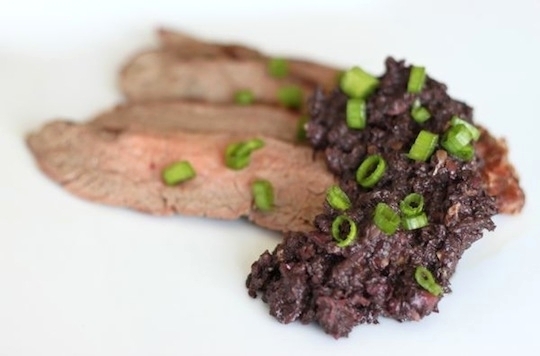 Seaweed and olives might sound like an odd pairing, but dulse tapenade will convince you otherwise. It’s a salty spread with rich umami flavor that can be modified to please your palate. Love the flavor of seaweed? Then go light on the olives. Not so fond of seaweed? Add a big handful of Kalamatas and you’ll barely taste the seaweed at all.
Seaweed and olives might sound like an odd pairing, but dulse tapenade will convince you otherwise. It’s a salty spread with rich umami flavor that can be modified to please your palate. Love the flavor of seaweed? Then go light on the olives. Not so fond of seaweed? Add a big handful of Kalamatas and you’ll barely taste the seaweed at all.
Either way, dulse tapenade is packed with vitamins and minerals, including vitamin E, iodine, magnesium, iron and copper. Not to mention all the other trace minerals your body is probably missing out on.
Olives are no slouches in the nutrient department, but sea vegetables are especially micronutrient-dense. Although seaweed is a staple in some cultures, it’s lacking in many others. If you’re not eating much seaweed, then dulse tapenade is a delicious way to work sea vegetables into your diet. It’s a super-healthy, super-flavorful and surprisingly versatile spread.
Still not convinced that sea vegetables and olives go together? Consider this: In a traditional tapenade recipe, anchovies are added, giving tapenade the same salty, umami flavor that seaweed brings. So why not use seaweed instead? Plus, the salty flavor of Kalamata olives isn’t too far off from the salty and fairly mild flavor of dulse.
In this recipe, the tapenade is used as a topping for garlic grilled steak. Dulse tapenade is also really delicious as a spread for Primal crackers or a sauce for Primal pizza and meatza. Use it as a filling for an Italian Turkey Loaf Burger. Or, just eat dulse tapenade with a spoon.
Servings: 4
Time in the Kitchen: 35 minutes
Ingredients:
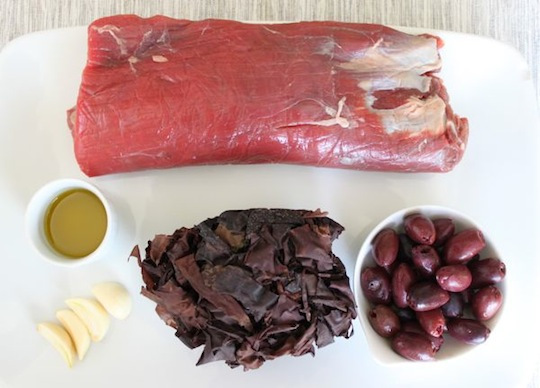
4 very finely chopped garlic cloves, divided
3 tablespoons olive oil, divided (45 ml)
1 1/2 to 2 pounds flank steak (680 to 900 g)
One 1.4 ounce package dried whole leaf dulse (40 g)
1/2 to 1 cup pitted kalamata olives (about 140 g)
Instructions:
Combine 3 of the garlic cloves with 1 tablespoon of the olive oil. Rub the garlic and olive oil all over the steak. Generously season the steak with salt and pepper. Set the steak aside for 20 minutes or so, letting the meat come up to room temperature.
Heat the grill to med-high. Cook the steak about 6 minutes per side with the lid down for medium-rare. Let rest 10 minutes. While the steak rests, make the tapenade.
Soak the dulse in water for 3 minutes until soft. Drain and then quickly rinse the dulse in fresh water. Squeeze out as much excess water as possible.
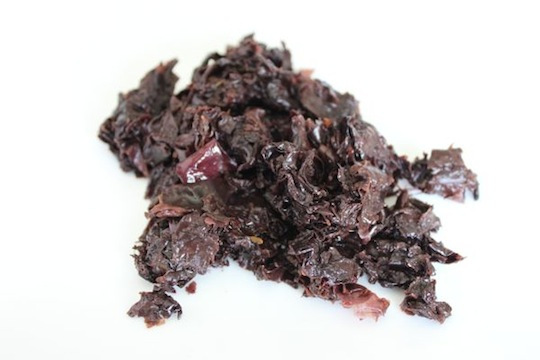
Warm the remaining 2 tablespoons of olive oil over medium heat. Saute the remaining garlic and the dulse for 2 to 3 minutes.
Scrape into a food processor and add 1/2 of the olives.
Pulse a few times, scraping down sides as necessary, to blend. Taste the tapenade. If the seaweed flavor is too strong for you, add the remaining olives until pulse until desired texture is reached.
Thinly slice the flank steak. Serve with a topping of dulse tapenade.

Not Sure What to Eat? Get the Primal Blueprint Meal Plan for Shopping Lists and Recipes Delivered Directly to Your Inbox Each Week

October 11, 2013
I Lost 105 Pounds in 12 Months and Changed My Life for Good!
It’s Friday, everyone! And that means another Primal Blueprint Real Life Story from a Mark’s Daily Apple reader. If you have your own success story and would like to share it with me and the Mark’s Daily Apple community please contact me here. I’ll continue to publish these each Friday as long as they keep coming in. Thank you for reading!
 Hi Mark,
Hi Mark,
I’m a 24 year old overweight guy from Austria (the state in the alps, not the one where kangaroos roam around  ). Sure, that prolly sounds like nothing special, but hold on!
). Sure, that prolly sounds like nothing special, but hold on!
I was the fat kid/guy for all of my life. As far as I can remember, I used to be fat. During childhood it didn’t really affect me in a negative way, though I remember my dad claiming when I was aged around 4 or 5, that I’ll look like a wooden barrel at age 14, if I keep on like that. Talk about learning to love yourself haha.
Anyway, up until junior high the weight never really affected my being that bad. I was sociable, had many friends and girls liked me as well.
As soon as I started junior high (around age 11) and hit puberty, sh*t slowly began to hit the fan. I started getting bullied, developed nerdy interests and the older I got, the more I began to shun myself from the outside world.
I even remember my parents telling me at age 12 that I will suffer from a heart attack by 20.
Since around age 11 I suffered from chronic bowel issues as well. Diarrhea, constipation and cramps were a daily occurrence for me.
By age 16 I was so depressed from all the bullying, that I fled into the world of massively multiplayer online role playing games. I was completely anti-social. That started a 3 year long addiction of doing nothing in my life but playing the same video game. Somehow though, miraculously, this kept me from gaining weight. I stayed around 120 kg (267 lbs) for this time. In British terms I was a NEET during this time.
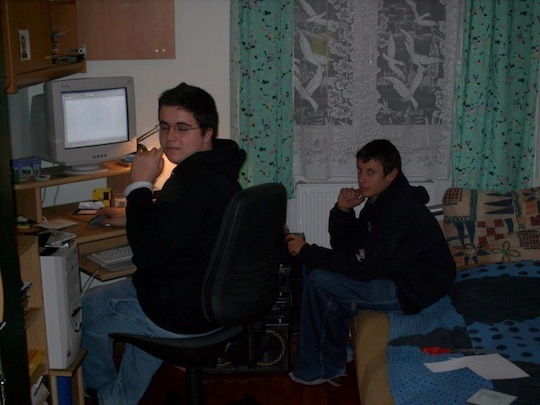
Obviously, fleeing into this magical world of elves, ninjas and pirates didn’t change my life for the better. After this time, which was filled with just as much drama as the time before, I realized that I needed to change. No one’s gonna help me except for myself.
Unfortunately, it didn’t make the click in my brain yet that was required to start changing my health. But the realization was strong enough that I needed to start changing my life path, career and personality-wise. I started looking for jobs that I knew I would enjoy, like online community manager and any other creative job within the European media industry.
In the spring of 2009, somehow I ended up with a game tester job at one of the biggest video game companies in the world. Overly excited I packed my bags and ran off to Germany to start my work there asap. It was fun, but peak season (August-December) was stressful as hell. So what’d I do to fight the stress? I began to emotionally eat, which over the course of a year brought me to my highest weight, 150 kg (330 lbs) in 2010.


In Germany I lived in a flat-share with 3 other people, luckily one of them moved out and instead a beautiful, funny and highly intelligent nutritional scientist moved in, because she started to work at the food planning of General Motors’ German division (Opel).
By that time I had the goal to work my way up the media industry and take care of my health, as soon as I have all the money I want. Thanks to her I slowly became convinced that by this time it’d be too late, I have to start right away.
She was taught the outdated principles of low fat, low protein, high carb grain based diets, so I followed that for a few months with calorie counting.
That worked nicely until my first vacation back at my hometown. I lost about 60 lbs in 5 months. But during the holidays all my will and principles broke loose again, so I gained all the weight back within 2-3 months.
This caused until summer of 2012 what in conventional wisdom would be called yo-yo dieting.
Luckily enough though, long before that, sometime in summer 2011 I found out about Paleo, Primal and Mark’s Daily Apple. I became a frequent MDA reader, caught up on all 140+ episodes of Robb Wolf’s Podcast and continued to listen, ate grain free, started CrossFit at CrossFit Werk (shoutout to Flo and his crew, great guys!) and so on. Like most people, you could say I was 80% Paleo.
But, and here’s the big but, mentally I wasn’t ready for it. A few months after I started Paleo in 2011 I became homesick for the first time and was really depressed for another 4 months. I just wanted to go home, but didn’t want to leave Germany without having a job position back in Austria. So I stayed and became more and more depressed. I literally wanted it all to end, I wanted to eat myself to death. So I did. During the homesickness I only ate the worst kinds of junkfoods and sweets all day long. Within the period of the depression I shot back up to 136 kg (299 lbs).
Then in July of 2012 my mind slowly started to think rationally again. At weight 136 kg, almost as fat of a belly as I used to have at 150 kg, I realized that I can’t let circumstances get to me. Like Bruce Lee said, to hell with circumstances, I create opportunities!
Since then I’ve given it my all. I’m 95% Paleo (once a week I drink alcohol based on Martin Berkhan’s Leangains recommendations and once every few weeks I make grain-free pancakes and/or eat potato chips). I dropped milk products because I realized that after consuming them I become HIGHLY emotional, and because of dropping grains and milk products, these days the bowel issues are nearly gone.
One thing I should also note, in July 2012, because of the emotional eating I was back at size XXXXL. Now I’m down to size L. I have to admit, I still have quite the belly, because in the past 13 months I did too much cardio instead of strength training, but now that I’m happy with the weight on the scale, I work even harder to replace my fat with muscle mass. I also really enjoy getting stronger strength-wise.

Weight-wise I’m now from 136 kg in July 2012 down to 88 kg in August 2013 (299 lbs to 194 lbs).
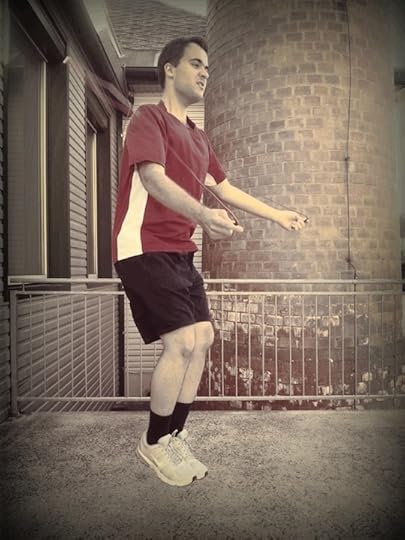
My personality also got a lot stronger from July 2012 ’til today. Back then I couldn’t talk to any pretty lady and never had a girlfriend. Now I can talk to any human being, no matter if female or male, ugly or pretty, now I only need to learn how to flirt haha 
Either way, my next big goals are set in terms of strength. Unfortunately, though to scoliosis I cannot even do wall pushups without suffering from pain in my shoulder joints. So I’m slowly working myself towards wall pushups, followed by inclined pushups etc., so in the future I will be able to do real pushups.

Okay, now it’s prolly time to start cutting my story short. Overall, life is good now. There’s still lots of room to improve, but I’m REALLY happy with where it’s going. If you would’ve told me 3 years ago that my life would be as it is today, I would’ve laughed at you in disbelief.
Because of this, I really want to thank you, Mark, the Paleo & the Primal communities, for all that you do. Without you all who knows where I would be today. Maybe I’d be dead.
So thanks a lot and all the best from Austria,
Daniel
P.S. As I’m still a success story in the making, in 12 more months I will write you another big email haha!
Get Your Omega-3s: Order Two Bottles of Primal Blueprint Fish Oil Capsules and Get An Additional Bottle Absolutely FREE

October 10, 2013
The Physiological Consequences of Being Hyperconnected
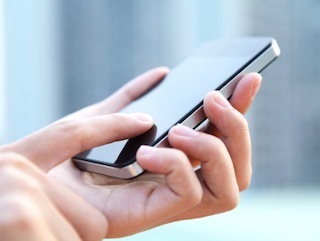 When most people, myself included, discuss the negative effects of staying glued to our smartphones, computers, tablets, and social networking sites at all times, they often focus on everything we miss out on: meaningful interpersonal interactions, quality time spent with our significant others, a beautiful sunset/rise, good books, quality sleep, a great hike, the felt presence of immediate experience, that car barreling down the street toward us as we head into the crosswalk focused on who liked our Facebook post. And those are all important reasons to limit your screen time, but recent research is revealing a series of physiological, physical, and psychological ramifications to being hyperconnected all the time.
When most people, myself included, discuss the negative effects of staying glued to our smartphones, computers, tablets, and social networking sites at all times, they often focus on everything we miss out on: meaningful interpersonal interactions, quality time spent with our significant others, a beautiful sunset/rise, good books, quality sleep, a great hike, the felt presence of immediate experience, that car barreling down the street toward us as we head into the crosswalk focused on who liked our Facebook post. And those are all important reasons to limit your screen time, but recent research is revealing a series of physiological, physical, and psychological ramifications to being hyperconnected all the time.
According to a recent survey of people in 65 countries, 73.4% of people own a smartphone. Those with smartphones check them an average of 110 times per day, which amounts to every five or six minutes spread out over a twelve hour period. Another study found a slightly higher frequency - 150 times per day. That’s a lot of people with instant, constant access to email, social networking, and text messaging. Not all of them will suffer all or most of these negative effects, but the draw of checking your phone “just one more time real quick” is obviously difficult to resist. Heck, most people don’t even try to resist it, because staying connected and apprised of everything everywhere can only be a good thing, right?
Let’s take a look at some of the possible consequences:
Text Neck
I first heard about this from Kelly Starrett. When most people text or use a smartphone, they jut their heads forward and bend their necks. It seems harmless and natural, but it places a huge amount of stress on your vertebrae (human heads are really, really big and heavy!) that compounds over time.
Gameboy Back
Pardon the incredibly dated reference to an obsolete gaming device (Gameboys were around, what, fifteen years ago?) and focus on the issue at hand: kids (and adults) who frequently game on smartphones and other handheld devices are placing their thoracic spines in flexion for extended periods of time. It’s similar to text neck, only instead of firing off a quick text, you’re playing a game for minutes or even hours at a time. This can cause the thoracic spine to follow the head and round, perhaps even leading to kyphosis. Growing kids whose skeletal systems are still developing are most vulnerable.
Text Claw
Human hands are incredible. They allow us to manipulate and create thousands of complex tools, tell stories through sign language or the written word, play instruments, lift 500 pounds off the ground, caress loved ones, and cradle a delicate egg or rip a phone book in half. They do a lot of different things, in other words, so when we send texts a hundred times a day and write entire emails using our thumbs, we put our hands through the same contortions over and over again and run the risk of overuse injuries to the tendons in our hands. Unfortunately, text claw isn’t the useful, fearsome bird-of-prey kind of claw. It’s the kind of claw that curtails our everyday abilities and causes immense physical pain. Text claw. Weird, I know. But apparently some people are suffering from it.
Sleep Texting
No, not drunk dialing; sleep texting. It’s a real thing. People are rousing themselves, still half-asleep, in the middle of the night to answer incoming text messages with garbled responses that they don’t remember sending upon waking. In and of itself, sleep texting is bad because it’s disrupting our sleep (even if we don’t remember waking up, we’re still waking up and we can’t just resume where we left off in the sleep cycle). It also suggests a deep and disturbing attachment to our phones.
Phantom Phone Vibration
This is the sensation of feeling your phone vibrating in your pocket even though it is not. Dangerous? No, but it’s a bit alarming to have your mind playing tricks on you like that, isn’t it? One researcher even thinks these phantom vibrations might be “increasing the flow of neurotransmitters such as norepinephrine, dopamine, epinephrine and cortoctropin-releasing hormone and decreasing the flow of serotonin, and gamma-aminobutyric acid.” To me, it sounds like the phantom limb phenomenon, only more sinister: in our minds, our smartphones have become as appendages.
Internet Addiction
Once derided by researchers, Internet Addiction Disorder is now mentioned in the latest edition of the Diagnostic and Statistical Manual of Mental Disorders (DSM-5) and the subject of reams of new research. Plus, even if “Internet Addiction” never receives official validation, people are displaying the classic symptoms of addiction, receiving Facebook “Likes” gives a hit of dopamine to your reward system, and people with IAD show similar neurobiological abnormalities with other established addictive disorders. Teens with IAD, for example, have elevated sympathetic nervous system activation with lower heart rate variability. The first IAD inpatient program has even popped up at a Pennsylvania hospital (it won’t be the last, I’d wager).
Depression
On the surface, one would think that checking our Facebook, sending texts, reading emails, and sharing Instagram photos should us feel like we’re establishing and maintaining meaningful connections with other humans, but the reality is that these pursuits taken to an extreme only make us feel more isolated from and less connected with real people. In fact, the more frequently you use social media or check your phone the more likely you are to report feeling sad, depressed, and lonely. A recent study in young adults showed that Facebook use predicts declines in subjective well-being, while “direct” contact with people does not. Some clinicians even have a name for it: Facebook depression.
On top of all those physical and psychological consequences, we’re also missing out on the other stuff I mentioned at the start – the conversations, the smiles, the laughs, the everyday bits and pieces of life occurring right in front of our perpetually averted eyes.
All that said, I’m no Luddite. I own a smartphone which I use daily, have a computer and a Facebook account because these are immensely powerful, useful tools that if harnessed correctly can improve the quality of our lives and our work. Plus, we don’t have to suffer from these maladies. Just knowing that they’re a possibility helps us avoid or mitigate them:
Text neck or Gameboy back? Bring the device closer to eye level, close enough that you can see what you’re doing without moving your head, neck, or flexing your thoracic spine.
Text claw? Don’t use a single thumb for everything. Use your index finger to type on your phone.
Sleep texting? If you’re not already doing it, I wouldn’t worry too much. If you are, stick your phone in another room, well out of arm’s reach, at night. And when you do wake up in the middle of the night, try not to make the conscious, waking decision to check your phone. It can wait. Really.
Internet-enabled or -enhanced depression and Internet addiction are bigger, gnarlier issues without easy answers. It’s not as simple as “just stopping” or “cutting back,” just as it’s not realistic to tell most alcoholics to “just quit drinking” or “switch to beer.” I’ve outlined some helpful strategies for reducing your time spent connected before, but I’ve also got a few additional tips:
Delete the Facebook app (or any app you need a break from) from your phone. You can always re-download the thing when you really have (want) to log on, but that’s a high enough hurdle to keep you from constantly, mindlessly checking it.
Call, don’t text. Instead of sending twenty consecutive text messages, consider placing a call and hearing another person’s actual voice.
Use on a schedule. Check your phone/email/Facebook/etc every, say, hour instead of as often as your compulsivity compels you.
Set boundaries. Only use Twitter for ten minutes a day, Facebook for five, Instagram for two, and so on.
Seek purpose. This is the biggie, folks. The main reason we get so caught up in screen time. Why do we cruise Facebook late at night looking at what everyone else is (supposedly) doing? Why do we whip out our phones at the slightest hint of a lull in activity? Because something is missing, and we know it. We don’t always know what’s missing. We just know – often subconsciously – that something isn’t right and we aren’t comfortable with our situation. It could be that girl we haven’t called yet, that story we’ve been putting off writing, that bill we need to pay, that friend we need to call and catch up with, that dog we need to walk, that CV we need to update, that paper we need to start, that barbell we need to lift, that spouse we need to wine and dine like old times. It might be something entirely mundane, idealistic or unknown. Seek a purpose, higher, lower, humdrum, whatever. Be the person with stuff to post (but refrain from posting about it!).
Well, I hope I both alarmed and inspired you. This hyperconnectedness issue is serious business. These technologies aren’t going anywhere so we need to develop better relationships with them. Let’s hope that, together, we can do it.
(Please note that the recommendations to limit screen time do not apply to your consumption of Mark’s Daily Apple and Primal Blueprint-related electronic media. Compulsive, frequent, feverish checking-in is encouraged.)
What about you guys? How do you handle smartphone, Internet, and social networking usage in your lives?
Thanks for reading and Grok on!
Get Your Omega-3s: Order Two Bottles of Primal Blueprint Fish Oil Capsules and Get An Additional Bottle Absolutely FREE

October 9, 2013
Is Barbell Dogma Doing More Harm Than Good?
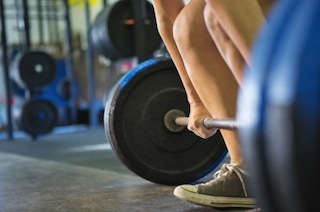 In the Church of Iron, weight machines are the ultimate sacrilege. Using them is a heresy punishable by banishment to the underworld of Pilates, ruled over by the fallen powerlifter Qurl Sin Thuh Zkwaut Raq wielding his unpredictable ball of Bosu and condemning the damned to an eternity of weak stabilizer muscles, convex buttocks, and wildly imbalanced quad-to-hamstring strength ratios. Absolution is nigh impossible. You so much as touch a cable pulldown machine and you’ll be forever barred from entrance into the heavenly Weight Room, where the blessed souls clothed only in three-prong leather lifting belts and 0.75 inch heeled lifting shoes feed upon the protein smoothies gushing forth from the spurting teat of the great Rippled Toad that give them the power to PR on the deadlift every day, walk (but never run, for conditioning is a sin) the halls of infinite power racks, squat until glutes grace ground with nary a butt wink in evidence, and be forever protected from any injury save permanently scuffed up shins.
In the Church of Iron, weight machines are the ultimate sacrilege. Using them is a heresy punishable by banishment to the underworld of Pilates, ruled over by the fallen powerlifter Qurl Sin Thuh Zkwaut Raq wielding his unpredictable ball of Bosu and condemning the damned to an eternity of weak stabilizer muscles, convex buttocks, and wildly imbalanced quad-to-hamstring strength ratios. Absolution is nigh impossible. You so much as touch a cable pulldown machine and you’ll be forever barred from entrance into the heavenly Weight Room, where the blessed souls clothed only in three-prong leather lifting belts and 0.75 inch heeled lifting shoes feed upon the protein smoothies gushing forth from the spurting teat of the great Rippled Toad that give them the power to PR on the deadlift every day, walk (but never run, for conditioning is a sin) the halls of infinite power racks, squat until glutes grace ground with nary a butt wink in evidence, and be forever protected from any injury save permanently scuffed up shins.
In the Weight Room, even a prolapsed anus caused by a 2-ton clean and jerk will cleanly heal with but a light dusting of holy lifting chalk. Yea, it is truly a heavenly thing to behold, amidst the angelic chorus of grunts, clanging plates and bars, the smooth retraction of a protruding colon back to whence it came. But that’s heaven. To get there, the faithful must toil on the mortal plane under rigid prescriptions forbidding certain behaviors and requiring others. As laid out in the Holy Moleskine Training Log: Thou shalt not covet thy brother’s squat rack, unless he engages in curls in which case he must be cast out. Thou shalt squat, or else suffer atrophy of mind, body, and spirit and be delivered down into Pilates upon death. Redemption is possible and requires the successful completion of 3 sets of 5 repetitions at twice bodyweight with perfect form. Thou shalt not jog. And so on.
But paramount above all other commandments is this one:
Thou must go into all the gyms, online message boards, and blog comment sections and proclaim the barbell gospel. Declare the glory of iron at all hours and decry the false fitness gods, growing not weary, for in due season you will reap eternal rewards.
If you’ve spent any time on fitness boards, you’ve seen this contingent in action, condemning non-barbell exercises and answering every other question with “Try squatting more.” They’re spouting the barbell dogma, but unlike most other dogmas, this one is particularly difficult to ignore. Why? Because all else being equal, using barbells will make you stronger, fitter, faster, and more powerful than using weight machines, doing bodyweight exercises, and other fitness alternatives. Furthermore, the strength gained from barbell training will have more carryover into other modalities. The evidence – both clinical and anecdotal – is clear on this (PDF). That’s what makes barbell dogma so darn persuasive; technically, they’re right. And yet I would argue that to suggest that someone who isn’t training with barbells is just wasting their time in (or out of) the gym is counterproductive and ultimately harmful. That kind of barbell dogma, while rooted in truth, does everyone a disservice (as all dogmas eventually do).
For one, it’s going to turn many people off from being active. You’ve spent your entire life sitting at a desk, can only manage a quarter squat (on your tippy toes!), and you’ve never touched a barbell. You’re riddled with crippling anxiety in public, super self conscious of your body, and would prefer to just do some simple bodyweight exercises at home for awhile until you’re comfortable enough to brave the gym – but everything you’ve read is telling you to “Be a man and squat!” For every online barbell enthusiast who’s immersed in the minutiae of technique, who watches lifting videos and reads lifting books and debates others who are just as obsessed as they are, there are thousands of people who just want to get “toned,” lose some weight, and get stronger without dealing with “scary free weights.” You might think they’re being ridiculous, but they do exist and they deserve to train just as much as anyone. And believe it or not (I’ve seen it happen), lots of people who first develop the confidence with machine or body weight exercises go on to use barbells.
Second, it’s going to inspire unprepared people to rush headlong into intensive barbell training without doing due diligence. People like to say that the barbell lifts are simple, that anyone can “just do them.” If we’re talking about a population of people who’ve been moving, squatting, lifting, and regularly walking in a healthy, biologically appropriate manner their entire lives, I would agree. But if we’re talking about a sedentary population of chair sitters and infrequent movers getting under a barbell without addressing their movement deficiencies, the risk of injury rises. Imagine the aforementioned office worker who can barely hit a quarter squat on his tippy toes trying to barbell back squat. Imagine the force with which his femurs would be trying, perhaps successfully, to blast through his patella without the modulating effect of his heels on the ground.
Third, even those folks who are successfully squatting, deadlifting, and pressing with barbells and spreading the good Iron word are missing out, because when you exclude everything that doesn’t involve a barbell you exclude worthwhile modalities like MovNat, martial arts, and gymnastics. When you’re too sore from your last workout or too worried about messing with your “gains,” you’ll miss out on backpacking trips, long hikes, going for walks with your loved ones, and playing sports.
Fourth, I present to you Keith Norris. The man is a beast, able to chase down gazelles on his fixie (provided he’s got enough coffee in his system), perform multiple consecutive pullup bar muscle ups at a bodyweight in the realm of 220 pounds, broad jump 8’5″, and trap-bar deadlift 400 pounds for 7 reps with ease. You’d think he was all barbells, all the time; you’d be wrong. Keith uses free weights and machines. In fact, he runs a facility specializing in high-tech resistance training machines. If barbells were the only way, this guy would be using them exclusively. But he’s not.
What’s my point here?
If you’re cowed and discouraged by the barbell dogma, don’t be. It’s not the only way. It’s not even the best way for everyone. Don’t be scared of it, mind you. Just know that you’re not wasting your time if you do the leg press instead of the squat, or pullups instead of barbell rows or prefer martial arts and parkour to barbell training. There is no one way.
If you’re untrained and inexperienced and want to work out with barbells, be careful! Work on your mobility, assess your weaknesses, read the experts, and start slowly. You can always add more weight to the bar, but you can’t erase an injury that occurs because you got ahead of yourself. And always, always listen to your own body. If something feels weird, stop doing it. If something hurts (and it’s not just a sore muscle), back off.
If you’ve only ever trained with barbells, consider trying something else. Work a bodyweight day into your rotation. Attend a MovNat workshop or jiujitsu class. Take a week off and go backpacking through the wilderness. You might be surprised at how your overall fitness, mobility, and even strength improve.
Overall, the “barbell is best” crowd has a good, worthy message, it’s just muddled and confusing and too authoritarian. I actually don’t disagree with them. I just think they’re a vocal bunch who are limiting themselves and the people who take their advice to heart.
What about you guys? What are your thoughts on barbell training? So effective to render everything else pointless? Or is there room for all sorts of movement and fitness modalities?
Thanks for reading and be sure to leave a comment!
Get Your Omega-3s: Order Two Bottles of Primal Blueprint Fish Oil Capsules and Get An Additional Bottle Absolutely FREE

October 8, 2013
Dear Mark: Salmon Pouches, Ray Peat, and Our Inherent Desire for Crispy Food
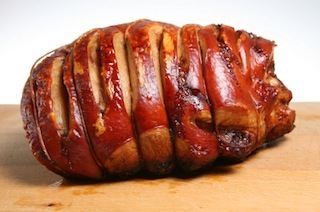
Ah, it’s good to be back with a regular old Dear Mark. Today we’re discussing the nutritional value of canned salmon, and whether the canning process negates some or much of the impressive nutrient profile of fresh salmon. After that, I discuss the dietary views of Ray Peat, an increasingly popular topic in the MDA forums and a seemingly wildly divergent way of eating. Is there any reconciliation to be made between Peat and Primal? I think so, actually. Finally, I explore why we might be inherently drawn to crispy, crunchy food despite the lack of potato chips, Fritos, and Pringles during the most formative years of our evolution.
Let’s go:
Dear Mark,
Do the packages of Chicken of the Sea Premium Wild-Caught Pink Salmon offer the same health benefits as a wild caught piece of salmon? Just looking for an easy way to get more salmon in my diet. Thanks!
James
For the most part, yes. Let’s break down the various health benefits and see how the canning process might affect them:
Minerals: Salmon is a rich source of various minerals, with selenium being the most prominent. Since heating doesn’t really break down minerals, you won’t lose any to the canning process. If you’re worried about minerals leaching into the salmon juice, just mix it into the salmon.
Vitamins: Thiamine is somewhat vulnerable to canning, but most of it is retained. Other B-vitamins (the only ones really found in salmon) are also well-preserved.
Vitamin D: Salmon is one the best dietary sources of vitamin D around, and canned pink salmon is no exception with around 400-500 IUs for every three ounces. Canning doesn’t change that.
Omega-3: Most research confirms that omega-3s are retained in canned fish. One study found that the most abundant fatty acid in samples of canned Mexican tuna was DHA. In another study, canned tuna, salmon, sardine, and jurel all retained high levels of omega-3s. Of course, there are some losses. Subjecting skipjack tuna to the canning process in another study totally eradicated the DHA and EPA levels. Meanwhile, the overall omega-6 PUFA content of the tuna increased due to migration from the canning oil.
It comes down to cooking time, temperature, and cooking brine/oil. Fish canned in brine or water are more susceptible to oxidation than fish canned in oil, with extra virgin olive oil being the most protective due to its polyphenol content (more protective even than synthetic antioxidant preservatives designed to prevent oxidation – nature wins again!). The description of the Chicken of the Sea canning process is generic, so it’s difficult to say anything definitive. But all in all I think canned salmon is often a great alternative to fresh.
Dear Mark,
What do you think of Ray Peat? I’ve noticed that some forum users like what he has to say. Where do you stand on his protocol?
Thanks,
Jon
Thanks for the question, Jon. Yes, I’ve seen that Ray Peat has been a topic of discussion in recent months. I’ll give you my take, but first a little overview on the “Peat protocol.”
It’s hard to talk about a “Peat protocol,” simply because the man himself hasn’t laid out a cohesive prescription (by design). From what I can tell, people are cobbling together a dietary regimen based on bits of advice Peat has doled out over the years in email consultations, excerpts from some of his research articles, and interviews he has given. I get the sense that his advice is very individualized and tailored to the person who’s receiving it rather than meant to be prescriptive to everyone. Most people are just reading the tidbits pulled from disparate sources and formulating a protocol based on them even though those tidbits weren’t necessarily intended for everyone. I doubt Peat himself lives off of nothing but gummy bears, OJ, coffee, and salted milk.
That said, there do appear to be some foundational principles that we can examine. Let’s take a look at them:
Saturated fats – Both camps agree that they’re awesome, stable and resistant to oxidation, and totally safe in the context of an otherwise healthy diet. The same goes for monounsaturated fats, which often appear alongside saturated fats. No arguments here.
Grains and legumes – Both camps avoid them, especially gluten-containing grains. Both camps agree that of the grains, rice and corn are the least problematic.
Use of the whole animal – Both camps support the consumption of the entire animal, including organs, glands, bones, and gelatinous connective tissue (which, remember, makes up a large percentage of the weight of a carcass that we usually just throw away nowadays). To achieve that, I’d like to see people making bone broth, eating oxtail and shank and chicken foot and turkey neck, and cooking up a pot of fish head stew every so often, not relying on gummy bears and marshmallows for their gelatin (although plain gelatin can be a helpful supplement and cooking ingredient). Judging from his article on gelatin, Peat would probably prefer gelatinous whole foods over reliance on purified gelatin, too.
PUFA avoidance – Peat and followers consider polyunsaturated fats to be toxic (both omega-3s and omega-6s), whether from whole foods or refined oils. I’ve always maintained that too many PUFAs, particularly omega-6 PUFAs, are problematic and inflammatory. The problem is that the studies they cite as evidence used refined oils, not food. They’re not feeding wild salmon to rats, or raw almonds to poultry. They’re giving refined diets rich in industrial seed oil because that’s the simplest way to modify PUFA content while minimizing confounding variables that might change the results (like selenium and astaxanthin in salmon or vitamin E and magnesium in almonds). I understand it, I just don’t think the results are necessarily applicable to whole foods that happen to contain PUFAs. And heck, the claims that PUFAs in any amount are hugely anti-thyroid and will shut your metabolism down just don’t pan out. One recent paper even found that omega-3s increased thyroid function in the liver. Given his recommendation of eggs and shellfish, I think Peat will admit a little whole food-PUFA is fine.
Sugar – Peat is “pro-sugar,” which many people interpret by eating plain white sugar by the quarter cup. I think this is a mistake and a far cry from what Peat actually promotes. From what I can tell, Peat is pro-sugar-via-fruit. Now, I’m obviously not a fan of fruit-based diets, but fruit is a whole unprocessed edible plant food, with all the fiber, vitamins, minerals, and phytonutrients that category entails. Fruit therefore is a legitimate source of calories, particularly if you’re active.
High-fat diets – Followers avoid high fat intakes, citing Peat, but Peat’s primary reason for limiting fat is to avoid PUFAs. He even says that “if the fat is mostly saturated, from milk, cheese, butter, beef, lamb or coconut oil, I think it’s usually o.k. to get about 50% of the calories from fat.” I think that’s reasonable.
My general impression is that the “Peat protocol” is anything but definitive, and what we can establish isn’t all that far removed from the Primal umbrella (albeit a high carb section of it). Now, as for the people mainlining table sugar and avoiding bananas because of the starch and skipping the leafy greens and berries because of the minimal amount of PUFAs and fearing muscle meat without an accompanying tablespoon of gelatin (or pack of gummy bears)? I think that’s all a little silly. Then again, if it works for you, it works for you. I’m not going to tell you to stop doing something that’s working (though I might suggest a few ways to improve).
You know, I bet Peat would be quite at home at PrimalCon. He might hoard the fruit and spike the coffee with crushed thyroid pills and aspirin, but I don’t think we’d catch him sneaking off to a grocery store for skim milk and strained orange juice or anything. His followers might be a bit disappointed in the California king salmon, though.
Why do we like or crave crunchy foods, especially since crunchy foods didn’t really exist to Grok? When I say crunchy foods, I’m more talking about modern crunchy foods such as chips. (Certainly you must have overheard someone at a party/gathering say they like “the crunch” of a chip or something).
When I think of anything crunchy on a Grok menu, I think of fresh peppers, carrots, or (stretching it here) cucumbers, or maybe even seeds or nuts – but there is nothing quite like a chip to give that ‘crunch’. Are we tapping into our primal genes here, or have we fallen victim to the chip companies who really sold us on the crunch[...]?
Thanks again Mark, hope all is well with you!
Ryan
I’ve seen things you people wouldn’t believe. A Thai family stripping a freshly roasted duck of its entire epidermis before touching even a morsel of muscle meat on the outskirts of Bangkok. I watched pork fat and pig ear shards glitter in the dark near a Malibu beach pig roast. All those moments will be lost in time, like spatters of fat to a grease shield.
If you were at PrimalCon Tahoe a couple weeks back, on the last night there, you’ll remember how Chef Aflalo made this braised beef dish that had the crispiest exterior (well, at least the part of the exterior that wasn’t submerged in braising liquid). It was incredible. I had to stop myself from snatching the crispy bits from other plates. And growing up in my family, the Pope’s nose on a roasted chicken (the fatty little tail nub) was prized and coveted by all.
My point? Crunchy or crispy food is great and inherently alluring, but I don’t think you need chips or crisps or industrial-sized vats of corn oil to get it. All you gotta do to turn fatty animal skin into crispy deliciousness is apply the simplest, most universal technology of all: fire.
Besides skin, you’ve also got all the edible arthropods humans and our ancestors have been eating for millions of years – the insects and the crustaceans. You may not have eaten a bug yourself, but you’ve probably stepped on one or two and heard the crunch. Just imagine that happening in your mouth, perhaps after a light roasting.
I imagine that some combination of crispy animal skin and crunchy arthropods – two relatively common dietary factors throughout human evolution – shaped our taste for crunch. Both bugs and crispy skin would have represented important nutrients to early humans: the protein and micronutrients found in insects and the animal fat found in animal skin (even an otherwise lean animal will have plenty of fat attached to its skin). The crunch may merely be a signal for healthy foods that’s been co-opted by food scientists. It certainly wouldn’t be the first time.
That’s what I’ve got, guys. What about you? What are your thoughts on canned (or pouched) salmon, Ray Peat, and crispy food?
Thanks for reading!
Get Your Omega-3s: Order Two Bottles of Primal Blueprint Fish Oil Capsules and Get An Additional Bottle Absolutely FREE

October 7, 2013
Finish Line: The 2013 Primal Blueprint 21-Day Challenge

Whoever says you need months to see major transformation or create dramatic change in your life needs some Primal schooling. Folks, another year, another Challenge has officially crossed the finish line, and let me tell you – it never, ever gets old. Not that the rest of the year at MDA is chopped liver (who came up with disparaging saying anyway?), but the energy of the Challenge is something I look forward to every year. I’m blown away by the enthusiasm, the creativity and engagement I see come through on the boards, the Grok gatherings and the reader content. It’s nothing short of awesome. Thanks to everyone who took up the Challenge this year and all those who offered support along the way. In the midst of a head spinning 21 days, so much happens I love to sit back at the end and take a satisfied look-see at everything that came together in the MDA site and community.
Grok-Worthy Competitions
Clearly, I’m not the only competitive one in this bunch! Can I say the post-its still get me every time? There’s something just so gratifyingly simple and subversive about it. And how about them groceries? There’s nothing like witnessing good Primal bounty. Those pictures are how it’s done, people. Thanks to all who offered their questions and support in the power of community contest and their feedback on our supplements and the upcoming Primal Teen book. And how about a hand for the companies who offered up their Primal products for the Challenge? From delectable Primal snacks to grass-fed beef to bacon, an Ergo Desktop to a Squatty Potty, no wonder the competitions were so hard fought. Grok never had it so good.
First-Rate Reader Content
I’ve been doing the Primal thing for quite a few years now, but when I see the ingenuity readers display in their Challenge submissions, it feels like a whole new game to me. The recipes inspire my own Primal cooking, and the workouts give me a whole new reason to look forward to some free time. Then there are the Grokfeasts! Yes, it was another amazing year of the Grok-inspired gatherings.
Congratulations again to Chi-town, but a big thanks to everyone who came together to feast.
MDA Highlights
Although the Challenge is always first and foremost about the reader experience, I always like to highlight some core principles in a new way or repurpose concepts for the Challenge. Such was the case with the now-”classic” posts (as readers told me), “The Primal Blueprint Refresher – A Dramatic Reading” and the “10 Habits of the Highly Successful Hunter-Gatherers” but also for the posts on abundance mentality, success strategies and Challenge Q&A. They’re all great refreshers for reinvigorating or deepening your Primal commitment at any point.
Now That It’s All Said and Done…What’s Next??
Tell me – and all of us within the MDA community – what this 21-Day Transformation Challenge has meant for you. How do you feel? What did you accomplish? What’s changed for you? Finally, what’s next?
Whether you’re a newbie or a veteran PBer, I think the Challenge opens up new dimensions of the journey. It naturally encourages us to think about what we want to change, where we can be more satisfied, why or how we might want to experiment for better results, more satisfaction and fuller healthy, happiness and contentment in our lives. What do you hope to find (or contribute)? Offer your feedback. Pose your questions. And congratulations on a Challenge well done!
Thanks for reading and joining us for the Challenge, everyone. Be sure to share your thoughts and successes on the 21-Day experience. What was your favorite part of the Challenge – and the MDA content and contests? Any recommendations for next year?
Get Your Omega-3s: Order Two Bottles of Primal Blueprint Fish Oil Capsules and Get An Additional Bottle Absolutely FREE

October 6, 2013
Weekend Link Love – 21-Day Challenge Edition
 This year’s 21-Day Challenge contests are winding down, but there are one or two left that you can still enter. Check them all out here and get your entries in before the deadlines!
This year’s 21-Day Challenge contests are winding down, but there are one or two left that you can still enter. Check them all out here and get your entries in before the deadlines!
One more thing: I’ve got a pair of tickets to the largest permaculture conference in the world, Permaculture Voices, and I want to give them away to a deserving reader. If you’re a permaculture student, enthusiast, or small-time farmer, this could be a great opportunity to see such lauded speakers as Michael Pollan, Allan Savory, Joel Salatin, and Geoff Lawton. So leave a comment below telling us why you want and deserve to go, and then my team and I will pick a winner.
For those who don’t win, you can use the coupon code dailyapple to knock the price of a ticket down to $710 from $960. Good until 10/31/13.
Relevant Research
If you’re still having trouble fitting your workouts into a busy day because they take too long, perhaps this news will make things easier: in recreational strength trainees, performing a single set of resistance training was just as effective as performing three sets for strengthening the upper body.
And if you’re doing “cardio,” it doesn’t take much to get the good stuff. Just six sessions of high intensity interval training was enough to improve fitness and increase mitochondrial density and function in the muscle.
Helpful Blog Posts
Need a new fitness routine? Hit a stall? Stuck in a rut? Dr. Andro explains why undulating your periodization might lead to better gains – and a renewed sense of purpose.
Fuel For the Fire
If your Challenge is to eat fewer carbs, you’re in good company. A Swedish expert committee has just concluded that low-carb diets are the most effective for weight loss in the short term. Make sure you stick with it, though; due to non-compliance, long term dieting (low-carb or otherwise) doesn’t seem to work for most people.
No, Burger King did not just come out with a healthy French fry. No, the Satisfries are not allowable during the Challenge. Sorry.
You may be avoiding GMOs, but I think we can all wholeheartedly (or begrudgingly) accept these GMO trees as safe – and awesome.
Contest Sponsor Discounts
Get 10% off your order at Steve’s Paleo Goods using the code ”MarksDailyApple2013.” Good until midnight tonight.
Want inexpensive (but not cheap) grass-fed meat? Tendergrass Farms has kindly provided a discount coupon for all Mark’s Daily Apple readers. During checkout, use NICE2MEATU to receive 15% off your entire order. This offer is good until 10/17/13.
Ever worked out with a dedicated training sandbag? Now’s your chance: at Ultimate Sandbag use promo code primalusb to receive 15% off any purchase through 10/31/13.
Tight muscles? Knotted-up gristly fascia that’s inhibiting your movement and sucking your will to live? Try a Radroller, and be sure to use the code MDAROLLER for 20% off your order. Good through today.
The Sling Trainer from Aerobis is a versatile training tool that you can take with you anywhere – and until 10/15/13, MDA2013 will get you 15% off your whole order.
Recipe Corner
On the eve of her latest cookbook release, Melissa Joulwan serves up some thyme-braised short ribs.
Need something (slightly) sweet to eat? Check out this less dairy-intensive adaptation of my peach clafoutis recipe: blueberry and banana clafoutis.
Time Capsule
One year ago (Oct 6 – Oct 12)
Why You Shouldn’t Burn More Than 4000 Calories a Week Through Exercise – Exercise is important. Vital, even. But too much isn’t just ineffective, it’s actually measurably bad for you.
Is Organic a Scam? – Nutrient Differences – Find out why your Challenge to eat more organic produce was probably a very good idea after all.
Comment of the Week
THANK YOU
THANK YOU
AND THANK YOU!!!!
Thanks to each and everyone of you, especially to the ones who voted for me.
Congratulations to the amazing GrokStar, (the third year competing!) to the funniest and cutest Los Flinstones (enhorabuena, Robert!) and of course to everyone who submitted a video, I know the great amount of work it requires…
And of course, thanks to Mark and the work bees for this great challenge, and for everything they share here to make us healthier and happier!
- Gotta love that Nacho Rubio.
Get Your Omega-3s: Order Two Bottles of Primal Blueprint Fish Oil Capsules and Get An Additional Bottle Absolutely FREE

Mark Sisson's Blog
- Mark Sisson's profile
- 199 followers




